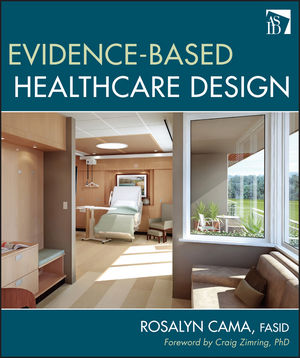Evidence-Based Healthcare DesignISBN: 978-0-470-14942-3
Hardcover
288 pages
March 2009
 |
||||||
Foreword by Roger Ulrich, Ph.D.
Acknowledgements.
Introduction: The Long View.
PART I: DRIVERS FOR CHANGE.
Chapter 1: Understanding the Shift Toward Evidence Based Design in Healthcare.
Evidence-based Design.
Four Components of an Evidence-based Design Process.
Levels of Evidence-based Practice.
Empowering an Interdisciplinary Team.
Herbert Essay: Holding to a Clear Vision.
Drivers for Change in the Healthcare Design Process.
Morrison Essay: Futurist’s Forecast.
Drivers for Change in the Design Professions.
Building a Body of Knowledge.
Checklist.
PART II: EVIDENCE-BASED DESIGN METHODOLOGY.
Chapter 2: Step 1: Gather Qualitative and Quantitative Intelligence.
Build an Interdisciplinary Team.
Conduct Investigations.
Malone Essay: Listening to Patients / Families: A guide to getting started.
Meilink, Thomas Essay: Weill Cornell Medical College / Weill Greenberg Center.
Benchmark against National Initiatives.
Document Process.
Checklist.
Chapter 3: Step 2: Mapping Strategic, Cultural and Research Goals.
Positioning a Project Toward Greatness.
Defining Project Drivers / Improved Outcomes.
The Art of Mapping a Vision.
IDEO Essay, Patient-Care Delivery Model.
Establish a Research Agenda.
Zimring Essay: OhioHealth Dublin Hospital Preliminary Research Ideas Preliminary Report.
Checklist.
Chapter 4: Step 3: Hypothesize Outcomes, Innovate and Translational Design.
Hypothesize Outcomes .
Watkins, Lawless Essay: Comprehensive Healthcare requires Comprehensive Evidence-based Design.
Design for Improvement: Dare to Innovate.
Haggarty, Starling, Mertens Essay: Changing the Cancer treatment Experience.
Build Mock-ups: Translational design.
Share the Process.
Checklist.
Chapter 5: Step 4: Measure and Share Outcomes.
Measure Outcomes.
Joseph, Keller Essay: The Role of the Researcher in the Design Process.
Survey Results from HKS, Ellerbe Becket and Kahler Slater.
Build Business Case.
Sadler Essay: Why Evidence-Based Design makes Good Business Sense.
Share Professionally.
Calkins Essay: What We Know: Evidence-Based Design in Long Term Care Settings.
Submit for Peer Review.
Hamilton Essay: Research and Competitive Advantage.
Checklist.
Chapter 6: Evidence-based Design in Practice.
A Look into an Evidence-based Practice that Recognizes the Need for Research That Improves Clinical Outcomes .
Parker Essay: Why has Anshen + Allen Embraced Evidence-based Design?.
Rostenberg Essay : Cultivating a Culture of Inquisitiveness: Integrating Evidence-based Design knowledge into a Design Practice at Anshen + Allen.
Color Photo Inserts.
Patient-Centered, Family Focused, Staff Supportive.
Hand Washing.
Reduction of Falls.
Like-handed Rooms.
Staff Efficiency.
Connection to Nature.
Daylighting.
Positive Distractions or Resource Centers.
Culture.
Sustainable.
Cooperative and Long Term Care.
Ambulatory Care.
Children’s Hospitals.
PART III: NEXUS.
Chapter 7: Growth Opportunities for the Design Professional.
Next Frontiers.
Future of Education & Practice.
Guerin Essay: Embracing an Evidence-based Design Approach in Education and Practice .
Berens: Essay: ASID, Design Research & the Future of Interior Design.
Future Certification.
Salvatore Essay: The Evidence-based Design Assessment and Certification Program (EDAC).
What Comes After What Comes Next.
Levin Essay: The Future of Evidence-based Design.
Index.



